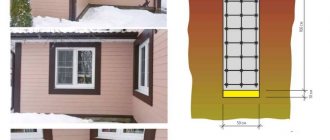Despite the apparent disadvantages of apartments on the ground floors (noise on the street, a high probability of theft, etc.), there is still an advantage of living on the ground floor - the opportunity to expand your living space by constructing an extension - a part of the building located outside the contour of the main external walls
But building an additional room/bedroom/veranda, etc. is not so easy, because first you need to legalize such construction.
How to legalize an extension to an apartment building in 2020, what is the procedure?
Step-by-step process for registering an extension to an apartment building
Many citizens do not know where to start the procedure for legalizing an extension or how to register an extension.
Documentation must be completed in any case - if construction of the extension has just begun and if part of the building has already been erected.
The procedure is as follows:
Step 1. Preparing documents
The owner of the apartment should collect the following documents for the apartment to which he plans to make an extension:
- construction project (must be ordered from designers);
- apartment plan;
- extract from the house register;
- certificate from the BTI;
- a document confirming ownership of the apartment (purchase and sale agreement, donation agreement, etc.);
- permission from the Rospotrebnadzor authority to draw up a construction plan in accordance with sanitary standards and rules;
- permission from the fire safety service;
- consent to legitimize the extension from the Committee of Architecture and Urban Planning;
- consent of neighbors to build part of a structure for an apartment building.
If necessary, additional documents will be required - acts from utility services on the availability of communications, photographs of an apartment building, etc.
Step 2. Obtaining permission to build a building
To begin the legalization procedure, you must obtain permission to add a balcony on the first floor of an apartment building. Where and how to obtain permission to build an extension to an apartment building? You need to contact the local government authority, namely the architectural department .
Within 30 days, employees of this department must review the submitted application and make a decision on it - to issue a construction permit or not.
If the applicant is refused permission, then he has the right to go to court with a statement of claim and the necessary package of documents for the apartment, as well as for the planned construction.
If the judge determines that the refusal to issue a permit is illegal, then the owner of the apartment, along with the court opinion, will be able to go to the BTI and register the extension.
But there are very few cases where the judge made the opposite decision. Usually judges make decisions not in favor of the owners, since very often people build extensions without complying with the rules and regulations.
And if the structure has already been erected, and the local administration authorities refuse to give permission, then in the end the competent authorities will have the right to demolish such an extension . Therefore, experts recommend that you first design an extension to an apartment building on the ground floor, and only then engage in construction.
Step 3. Construction work
If the local authority's architecture department has issued the applicant with a building permit along with a plan, then it's time to start building the extension.
It is imperative that construction be carried out with the permission of the gas service, Gorvodokanal, and electrical networks.
Step 4. Delivery of the object
When all work to legitimize the extension is completed, the owner of the apartment to which the additional building belongs must issue an acceptance certificate for the object with the contractor who carried out the construction work.
If the extension was erected by the owner of the living space himself, then the commission should include employees of utility services, a design company, and a representative of the local administration.
Step 5. Preparation of documents for the newly erected extension
If the commission determines that the structure complies with all construction and sanitary standards, then the owner will need to apply to the BTI to obtain a new technical passport, and then to Rosreestr to make changes to the Unified State Register of Registration (USRN) extract.
How to legalize an extension to a private house
It is also necessary to legalize non-permanent structures, but this is very simple and can be done even after you have built them. Just take the documents home to the BTI and write a statement about the changes to the technical documentation. The acceptance committee will arrive and draw up a refurbishment report.
But if we are talking about legalizing a capital extension, then everything is more complicated. It can be registered after the final construction, but it will require additional registration in court as an unauthorized construction. To avoid this, it is better to do this at the design stage.
The following documents will be required:
- confirmation of ownership of land and house,
- site plan and technical certificate,
- cadastral plan,
- building design,
- if the house has other owners, they must submit an application for work,
- consent of neighbors,
- conclusion of gas, energy or water and sewerage organizations on the safety of connecting the facility to communications,
- permissions from firefighters, SES and architectural department.
All documents along with the application must be submitted to the local government ; if there are no violations, then you will receive a document on consent for construction. When you finish it, you need to call the commission to draw up an acceptance certificate. The issued conclusion on compliance with standards is referred to the BTI, where changes are made to the technical documentation. After this, the object is registered in Rosreestr and a fee is paid for re-registration of a private house.
How to legalize an extension if it has been built a long time ago?
If the owner of the apartment unauthorizedly erected an extension without obtaining a building permit and without the consent of all neighbors, then according to Art. 222 of the Civil Code of the Russian Federation, such an extension is subject to demolition.
In some cases, the extension may be left, but only if:
- the building complies with all construction rules and regulations;
- the erected structure does not violate the rights and interests of other persons (not only neighbors, but also other people who may be disturbed by the extension in some way);
- the extension does not threaten the life and health of people.
If the extension was erected without permits and approvals, that is, without permission, then the person to whom it supposedly belongs will not have any rights to it. This means that he will not be able to sell it, donate it, bequeath it, or perform any other actions with it, since legally the building does not belong to him.
If the extension has already been built, then it is still possible to legalize it, but it will be much more difficult . First, you need to again go to the architectural department at the local municipality and get urban planning conditions.
If there are any documents for the construction (for example, a certificate of completion of work, contracts, expert opinion, design documentation), then you also need to take them with you. Within a month, the created commission reviews the applicant’s appeal and makes a decision whether to grant permission for legalization or not.
If approval is received, then the owner must contact utility organizations - gas service, water supply, energy supply, fire organization to approve the erected structure.
He must also obtain the consent of all owners of the apartment building that they are not against the extension. And only when everything is agreed upon and the documents are ready, then the owner of the premises can confirm ownership of the extension.
Reasons for refusal to legalize an extension to an apartment building
The reasons for refusing to legalize an extension even at the stage of its construction may be the following circumstances:
- if the apartment building is an architectural value, a monument;
- if the neighbors are against an extension to their house;
- if the constructed structure does not match the existing plan;
- if technical requirements were not met during the construction process;
- if building materials do not meet standards.
Useful tips
Before figuring out how to legalize an illegal extension to an apartment building, you need to consider the following points:
- It is best to arrange the extension as a separate property;
- it is desirable that the building be a non-residential premises (veranda, balcony, etc.);
- ideally, if the owner privatizes the site on which the building is erected;
- Before submitting documents for legalization, the owner should collect a complete package of documents for the apartment.
Before dealing with the issue of building and legalizing an extension, you must:
- ask the local municipality whether it is possible to make an extension to an apartment building or not;
- enlist the help of an experienced lawyer who will not only help collect the necessary package of documents, but also, in the case of local authorities refusing to legalize the extension, will help the plaintiff in court.
Procedure for registering an extension to a multi-storey building
It is worth noting that only non-residential premises can be attached. Therefore, by expanding your living space and making a separate room out of the extension, it will be problematic to prove that the premises are non-residential.
Let’s look at the algorithm for how to legalize an extension to an apartment building.
- The first step is to collect the package of documents described above.
- Then contact your local government in person and draw up an application using a special form. Attach documents to it and submit for review.
- If nothing is violated during the design, then the local government will have to approve the construction plan and issue a permit for it.
- You should definitely take into account the fact that if the building has already been erected, then it is considered illegal and obtaining documents will be a little more difficult. To avoid fines, it is necessary to contact local authorities as soon as possible to legalize it.
If the extension is completed in accordance with all the rules and regulations, but the permit is still issued, then it is recommended to contact the local court in order to legalize the premises through it. Of course, ideally, it is advisable to obtain permission for an extension to an apartment building in advance.
In most cases, in multi-storey buildings, extensions are made only on the first floors, because they are much less hassle. But here, too, there is one factor that can nullify all attempts to legalize the extension.
If it is built on a plot of land that does not belong to the owner of the apartment, then it is illegal and subject to immediate demolition.
It is worth noting that illegal extensions are subject to administrative penalties in the form of fines, so it should also be taken into account that it will take time to register the extension.
Such procedures can last approximately 6 months. This is without taking into account the fact that obtaining permits and collecting documents can delay the process even more.
Design of a non-residential extension to a house
When it comes to extensions to non-residential premises in an apartment building, then this may mean that the structure may be a non-permanent object - one that does not have a foundation and which can be easily and quickly assembled/disassembled without the need to erect walls.
For example, it could be a canopy, a showcase, a staircase . No special permits are required for such extensions. But the owner will still have to draw up an act of refurbishment of the apartment.
Permission for an extension to an apartment building
In an apartment building, an apartment located on the 1st floor of the building has 2 rooms attached on land owned by the owners of the premises, and 1 room on municipal land. The owners do not show permitting documents. What should have been the actions of the owners of the extension in order to obtain the proper permission. And now how should the management company deal with this situation - declare it illegal through the court? Or wait to collect the necessary documents from the owners?
According to sub. 2 p. 2 art. 44 of the Housing Code of the Russian Federation, decision-making on the limits of use of the land plot on which the apartment building is located falls within the competence of the general meeting of owners of premises in the apartment building. Consequently, in order to place it on a land plot that is part of the common property of the owners of premises in an apartment building, it is necessary to obtain an appropriate decision from the general meeting of owners. Otherwise, the owners have the right to demand the demolition of the erected extension, since by virtue of Art. 304 of the Civil Code of the Russian Federation, the owner may demand the elimination of any violations of his rights, even if these violations were not associated with deprivation of possession.
Also read: At What Amount of Debt Can Bailiffs Describe Property?
Legalization of an extension through the court
If the local administration refuses to legalize the extension, but he knows for sure that he has the right to build the facility, then he must file a claim in court.
The following must be attached to the claim:
- documents confirming ownership of the apartment;
- blueprints;
- official approvals with service providers (gas service, energy supply company, heat supply company);
- written consent of neighbors.
Can I legalize an extension to a house with 4 apartments?
To register ownership you will need: a document confirming ownership of the object, supplemented by an extension (from July 15, 2020, this is an extract from the Unified State Register); certificate from the BTI; act of approving the extension with neighbors; project and plan of the extension with its photograph; acts of public utilities on nearby communications.
Despite the fact that the house is called a barracks, it is not an individual housing construction project. This is an apartment building in which such additions are illegal, since such approvals require reconstruction of the entire building. In fact, this is the same as legalizing the unauthorized addition of another floor in an apartment building.
Answers to questions on the topic
Is it possible to somehow check the legality of an extension to an apartment building?
Yes, you can . Typically, extensions are built on the territory belonging to the entire house. This means that you can check the legality of the extension by submitting a corresponding request to the service company, asking them to show him the consent from all the owners of the apartment building for the construction of the extension.
Is an extension to an apartment building considered common property?
If the land on which the extension was built was not privatized by the owner of the apartment, then such an extension is the common property of the apartment building.
To legalize an extension (already built or planned), you must contact the architecture department of the local administration and submit a corresponding request.
If approval is received, then the next step is to obtain the consent of the neighbors for the construction of the building, as well as all utilities serving the house. If a refusal is received, then you can go to court and try to resolve the issue of legitimizing the building through justice.
But no matter how difficult it is to legalize an extension, it is necessary to understand that if you do not draw up documents for the structure, the owner will not have any rights to it.
In addition, he may be held administratively liable for self-construction. On top of that, they may be required to demolish an illegally erected extension to an apartment building.
Extension to a wooden house
The advantage of private real estate lies primarily in the fact that you can easily make an extension to a wooden house without problems and significant costs. For example, you can quickly and easily make an extension of 10-15 m², which serves as a veranda, kitchen or place for receiving guests. The addition to the main house must be done so that everything looks harmonious, and at the same time is comfortable and functional.
What to make an extension to a wooden house from
It is also worth paying attention to the materials from which the extension is made. If the house is wooden, then it is quite possible to supplement it with square meters of wood or even timber. This way the overall concept of the building will not be disrupted, and everything will seem more beautiful and cozy. Wood not only simplifies the work on the product, but also saves a lot of money. The big advantage of this material is that it is quite warm. However, to use the premises all year round, it is still worth carrying out additional insulation work.
In some cases, craftsmen choose brick for work. This is a more expensive material, but it has its advantages. First of all, bricks always retain heat well, so minimal insulation work will be required. In addition, maintenance of the extension will be simple, which distinguishes this material from wood.
However, when an additional brick room is added to a wooden house, it may not look very good. Therefore, you will have to choose between practicality and appearance. Or, as an option, you can then use external finishing materials of the same type on the entire house at once, including the attached room.
Timber extension
Do-it-yourself outbuildings made from timber look very nice. This is a durable material that will last a long time if you care for it properly. The appearance of the building itself is immediately transformed, and the house becomes like a fairy-tale hut. But the price of quality material of this type can be high.
The most inexpensive option is considered to be a do-it-yourself frame extension to a private house. Such construction methods have recently become very popular. Manufacturers offer to build entire houses of 2-3 floors in a short time. As for the extension, its construction in this case will be inexpensive. Frame buildings always require high-quality insulation and waterproofing. But still, they significantly outperform all other options in price, speed of work and even appearance. A frame extension will look good next to a wooden or brick house. This is an excellent option for budget-conscious owners.
Where to begin
Before you make an extension to a brick house or any other house with your own hands, you must first coordinate this with government organizations. Initially, design documents are drawn up taking into account all the nuances, but the work with government agencies does not end there, since upon completion of construction the extension will need to be legally registered. All such issues are resolved in the administration of the locality or in multifunctional centers.
You should not start work before all the details have been agreed upon. Otherwise, if something goes wrong, you will have to remove what has already been created, and this is troublesome and expensive.
The construction of the extension must be approved
Next, you need to purchase the material according to the planned estimate. It can be wood, timber, brick or stone. It must be taken into account that the type of materials must meet all the requirements of the building. If it is planned to be small and will not be loaded with a powerful roof, then you can take an ordinary tree. For permanent buildings it is still worth using stone or brick.
Experts strongly recommend checking all the nuances at the initial stage and consulting with professional architects. This is especially true in cases where heavy materials are planned to be used. Of course, the extension is not a second floor. However, even this can significantly load the main building. Therefore, before starting work, it is necessary to carefully check the serviceability of all components, the quality of the foundation and consult with specialists.
If building an extension seems like too much work, you can entrust it to professionals. In this case, you can save not only time, but money. If you opt for a modern frame option, it will be both beautiful and cheap. And the main thing is that such buildings are very light, so they do not load the main building at all.
Those who decide to make an extension to their home with their own hands should take into account that incorrect actions will lead to the load on the structure being too large. If the house is old, a professional preliminary diagnosis is necessary. An insufficiently strong foundation can cause the building to completely collapse, so when creating an extension, the master risks being left without housing at all.
Extension construction technology
As for how to make an extension to a house, the main thing is not to damage the main house and gain additional square meters. To do this, it is necessary to carry out high-quality preparatory work before starting construction. They must be multifaceted, that is, every detail must be studied.
The wall of the extension must be tightly adjacent to the wall of the house
First of all, it is necessary to check the quality of the foundation, its depth and width. This will determine whether the foundation can withstand the additional load of an extension.
In order to get a warm building, its walls must fit tightly to the main building. But this is only permissible if the structure is well preserved. In addition, you need to immediately think about movement options, namely doors and passages. It is quite possible that in the place where the extension to the country house will be connected to the main building, it will be necessary to make an additional arch under the door. Here it is necessary to clarify whether the wall will withstand this. Sometimes it happens that the walls look quite normal. But once you start diagnosing, numerous shortcomings are revealed.
Special requirements are always placed on the roof. It should be light enough and match the type of construction. There are 2 options for how to properly install a roof in an extension to a house. In the first case, it can be a continuation of the main roof, and in the second - a separate roof. Both one and the second method have their pros and cons. If you make a solid roof, the entire structure will look beautiful and harmonious. But there will be one minus indoors, namely a sloping roof or the need to build a small attic and additional insulation. A straight roof does not look very nice from the outside, but on the inside it will be a more convenient option for further interior decoration.
It is better to redo the roof taking into account the extension
Extensions that will be made of wood require special attention. This material is different in that it requires shrinkage. This process takes a certain amount of time, and sometimes reaches several years. Therefore, during the first years of use, the attached structure may settle and move away from the main wall. If it is initially fastened very tightly, it may damage the main wall. Therefore, the wooden frame must be left at first. Only after it has settled can you begin to design and strengthen the wooden extension.
As for the foundation for the extension, it does not matter much. If the main building is on a solid and high-quality foundation, then a pile foundation can be used to build an extension.
It is believed that making an extension to a wooden, brick or stone house is a very simple task. In fact, it is much easier than building a second floor. However, if certain requirements are not met when constructing an extension, this can have a very bad effect not only on the quality and functionality of the new building, but also damage the existing building. Therefore, you should be extremely careful and attentive.
Simple extension to a wooden house
The complexity of the work always depends on the type of project. Some try to make the extension create additional space, but also become a decoration of the building. But such options are quite complex both in execution and in choosing the right materials. If you don’t want to deal with difficulties, you can make a simple extension with your own hands quickly and inexpensively.
The first step will be to select the optimal location for future construction. At this stage, you need to assess your financial capabilities, select suitable materials, decide on the size of the building and resolve the issue of permitting documents.
Strip foundation for a timber extension
Next, you can proceed to the foundation. For a simple and light structure there is no need to make a powerful base. Most often, craftsmen refuse a monolithic foundation and opt for a strip type or columnar base. For a small frame extension or veranda this will be quite enough.
Before you build walls, you need to take care of the arch for the door from the house. In order not to destroy part of the wall, it is recommended to make a passage in place of an existing door or window.
After the foundation is poured and it is completely ready, you can begin to work on the walls. The easiest way is to make extensions to wooden or brick houses from solid sheets. That is, the extension will be of a frame type. It is advisable to place the posts for fastening the panels and further installation of the roof at a distance of about 1.5 m from each other, but no more. After they are securely secured, you can begin lining the walls. The final stage will be the installation of the roof and complete sealing of the room.
Frame extension on a columnar foundation
Experts most often recommend a roof for extensions that will be a continuation of the main roof. This way the whole building as a whole will look more harmonious and attractive. The extension will no longer look like a growth on the house, but will become a full-fledged part of it. If you use the same materials to decorate the facade as for the house, then everything will look very harmonious. But there is no need to rush with the exterior decoration. In addition, you need to wait some time before installing windows and doors. The extension needs to be given time to stand and settle. Only after this can further work be continued.
Insulation of the building
In order for the room to be used at any time of the year, you need to know how to insulate the building. This is not a difficult job, but it requires compliance with certain rules. First you need to choose insulation. The most popular materials are Izover, Izorok, URSA and Rockwood. All of them are inexpensive and consist of mineral wool.
Insulation of a frame extension
Most often, mineral wool is used for insulation. It is laid under sheets of plasterboard, which are then used to cover the walls and ceiling. But the insulation work does not end there. All seams between the sheets must be carefully sealed with putty. Only after this can you begin further decoration of the walls, that is, painting, wallpapering and other types of finishing work.
But in order for the room to be suitable for use in winter, all windows and doors must also be insulated. For this purpose, special materials are used to retain a lot of heat in the house.
With the right approach and quality work, you can live in a room you built with your own hands at any time of the year. From an ordinary summer veranda it will turn into a full-fledged building where you can equip a living room with a fireplace or a room for another purpose. Insulation work for an extension with an area of 12 m² and a ceiling height of 3 m will not cost too much.







